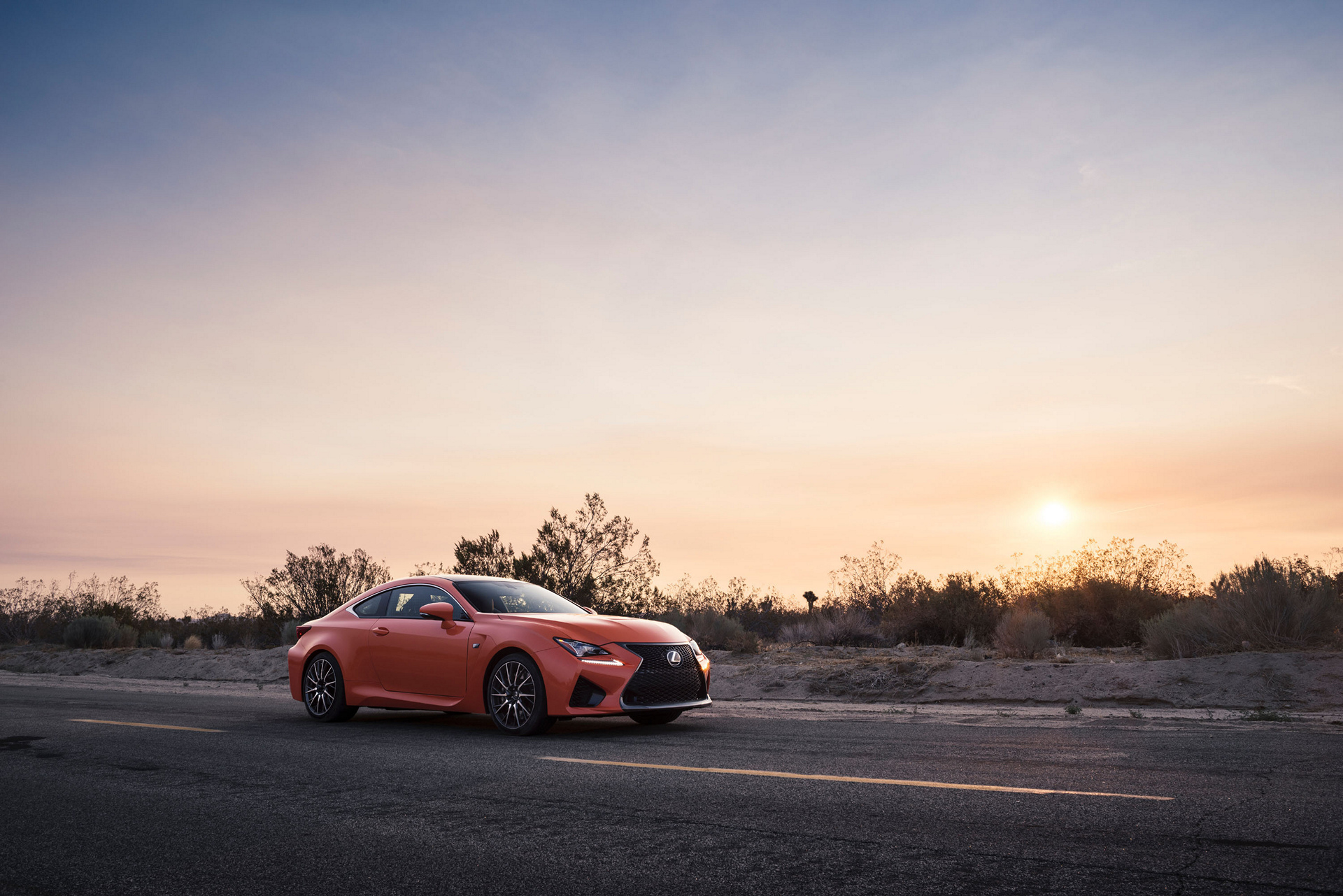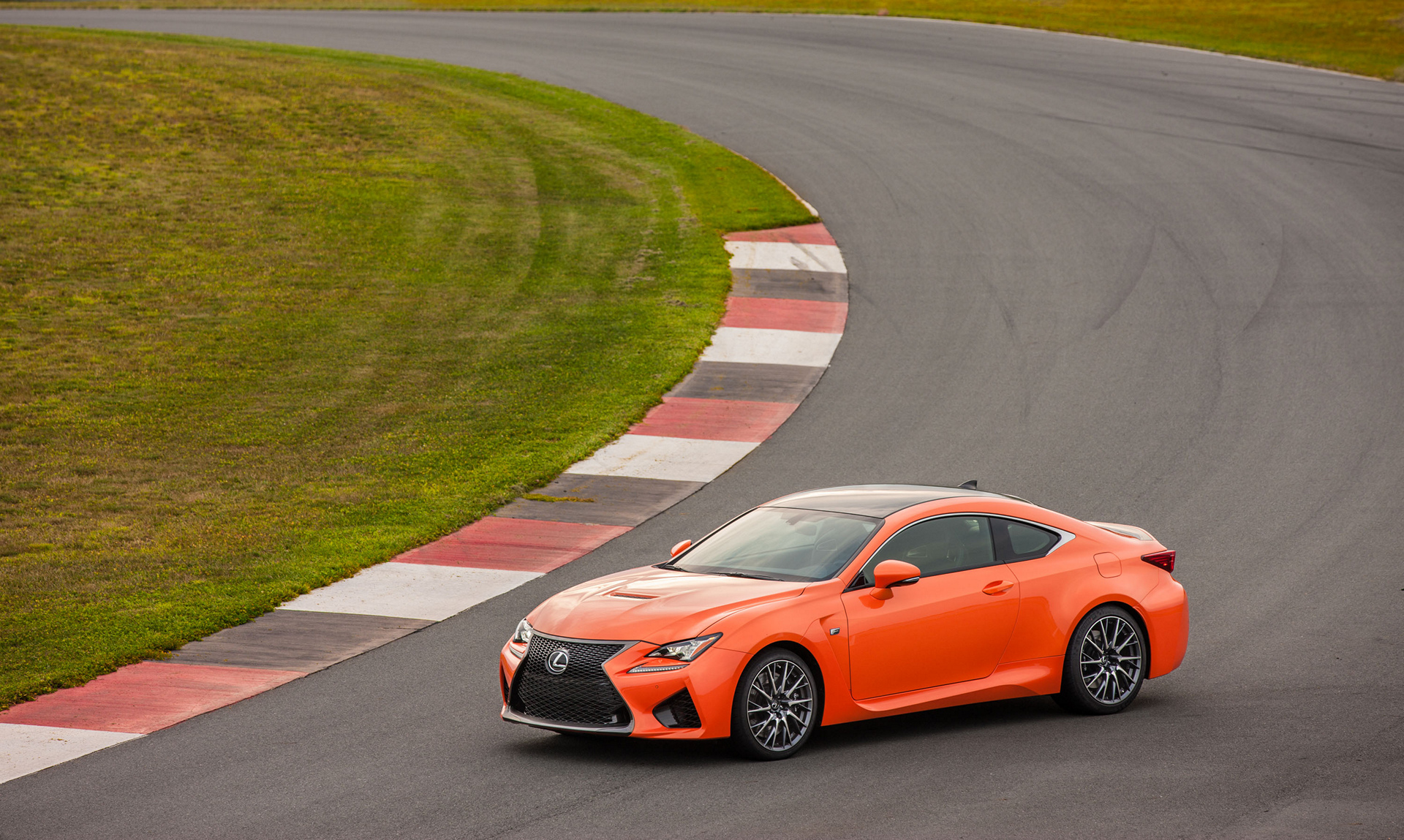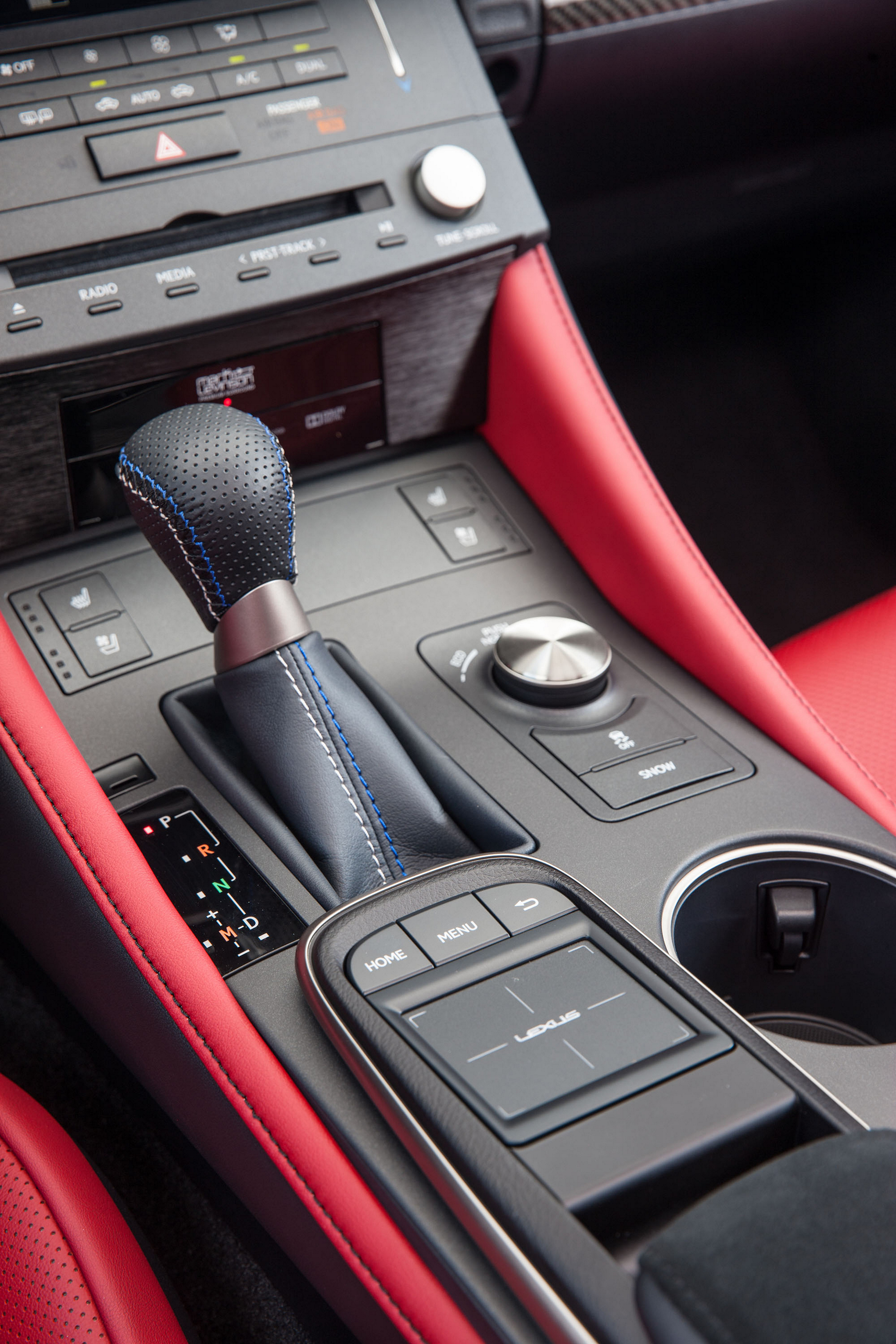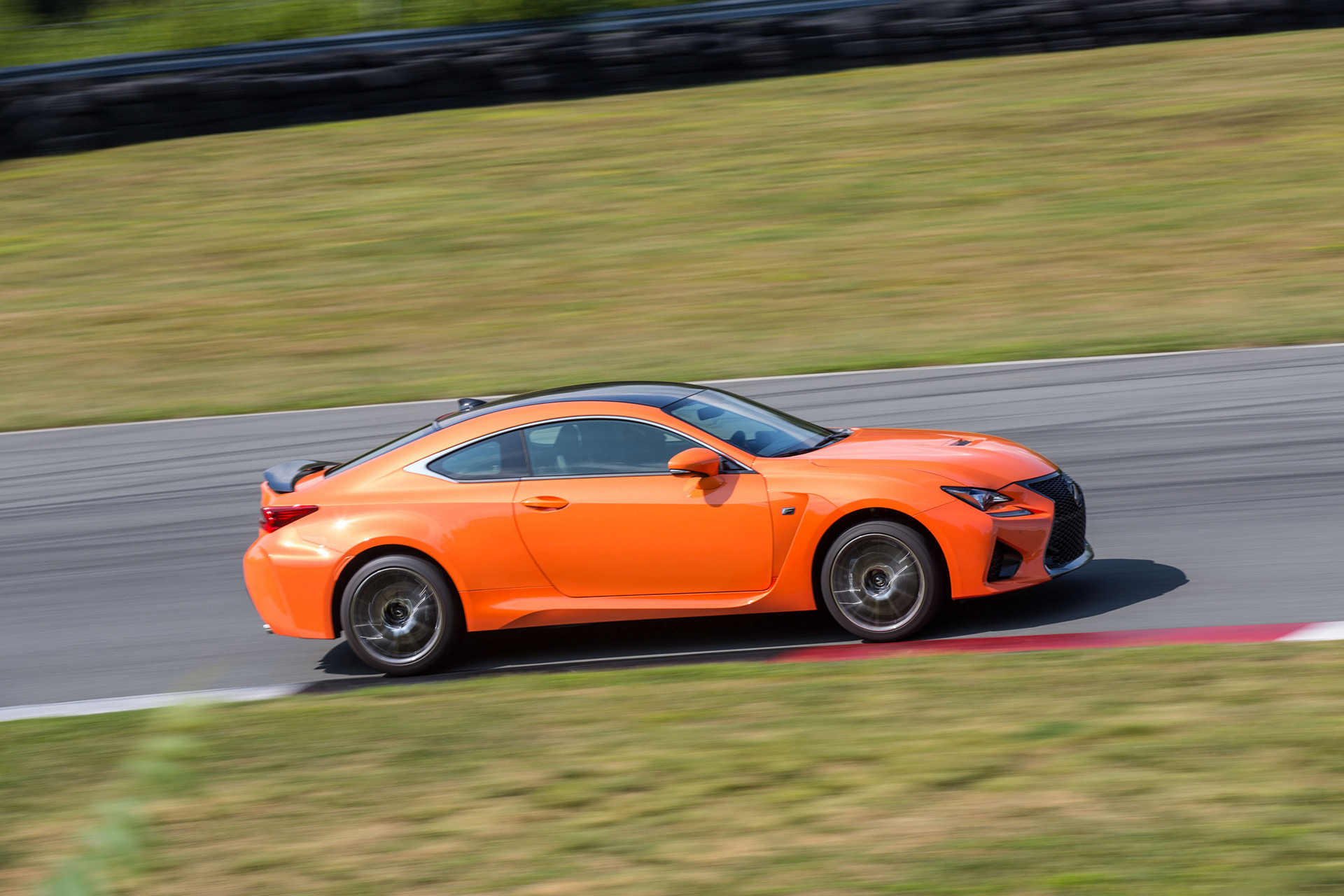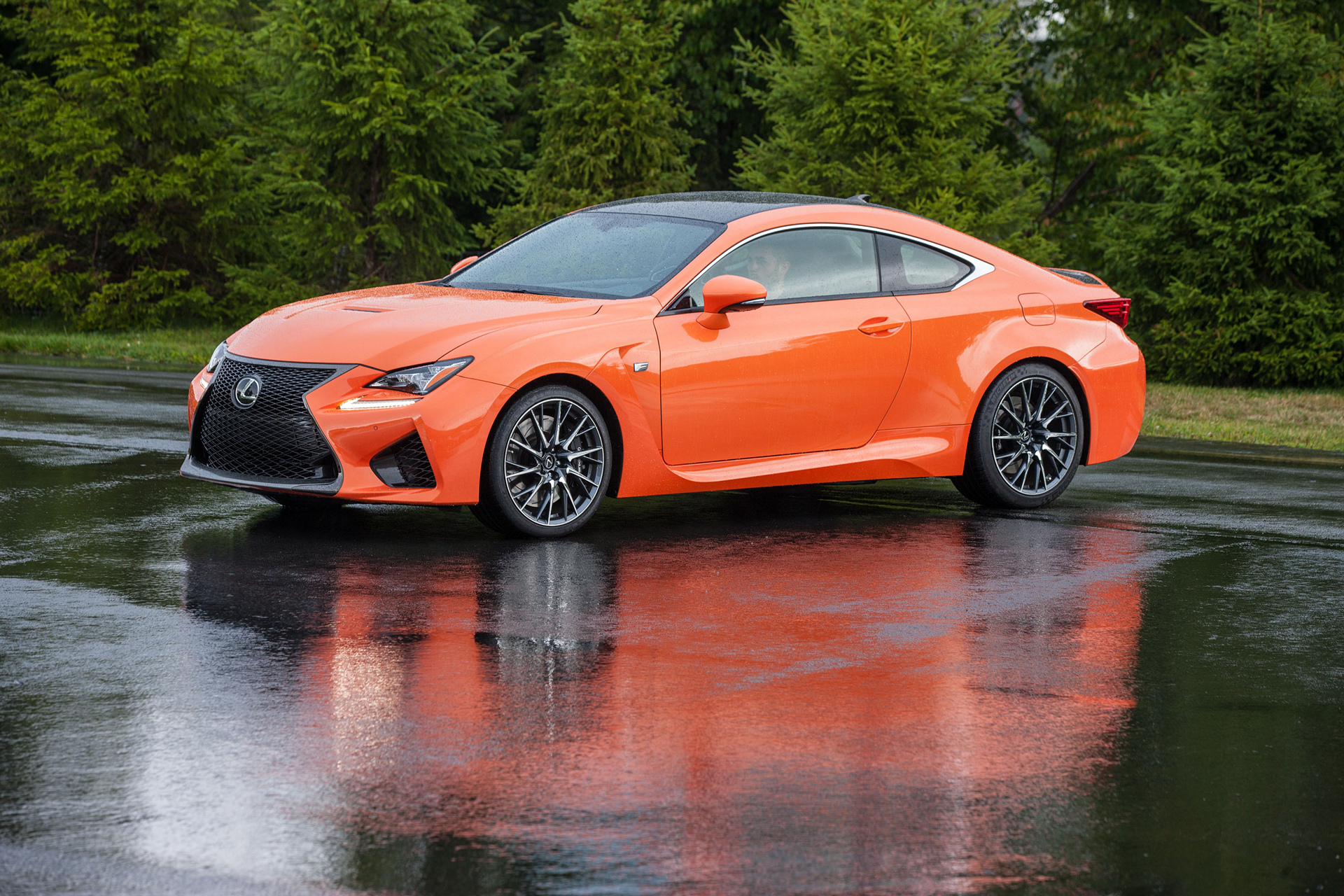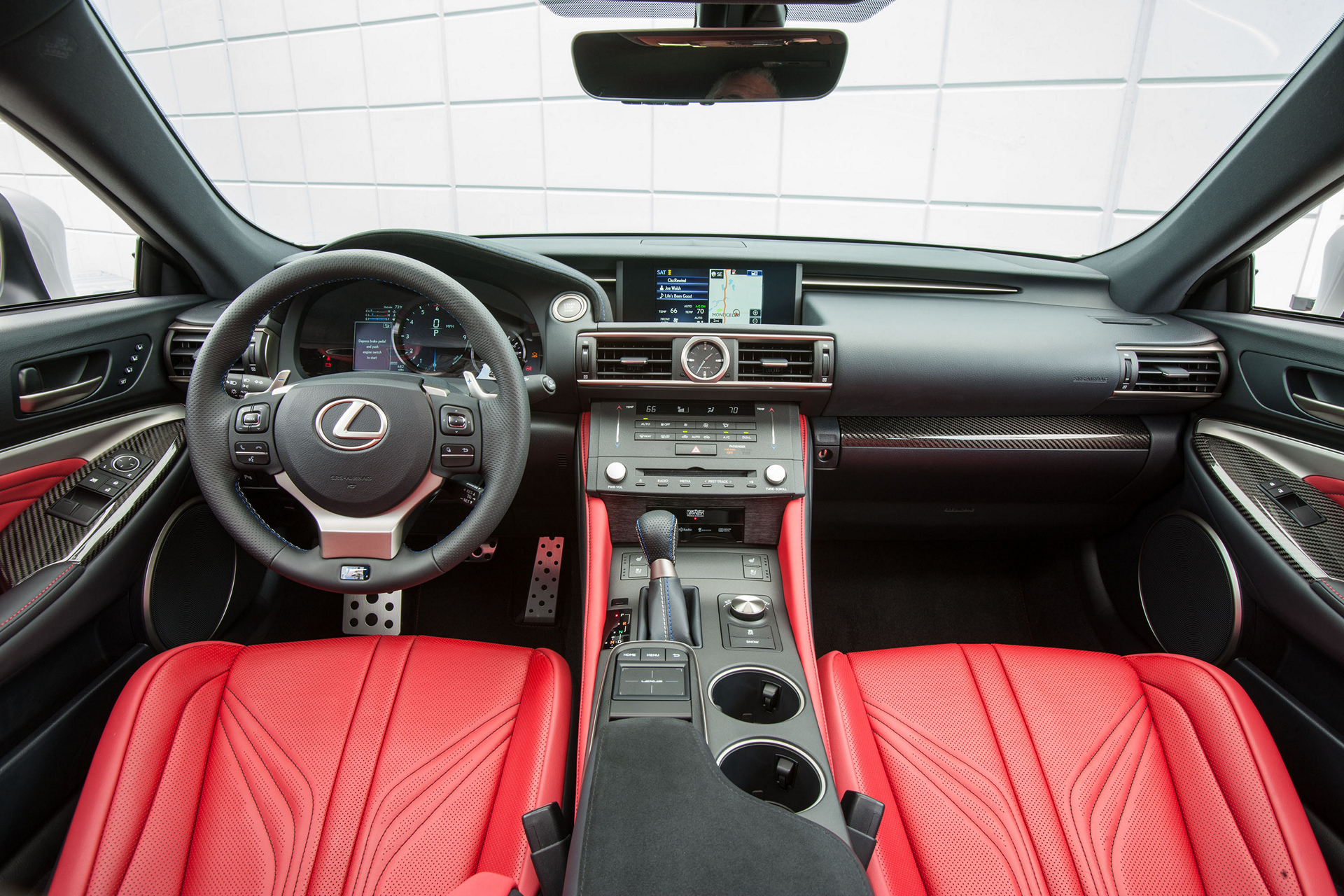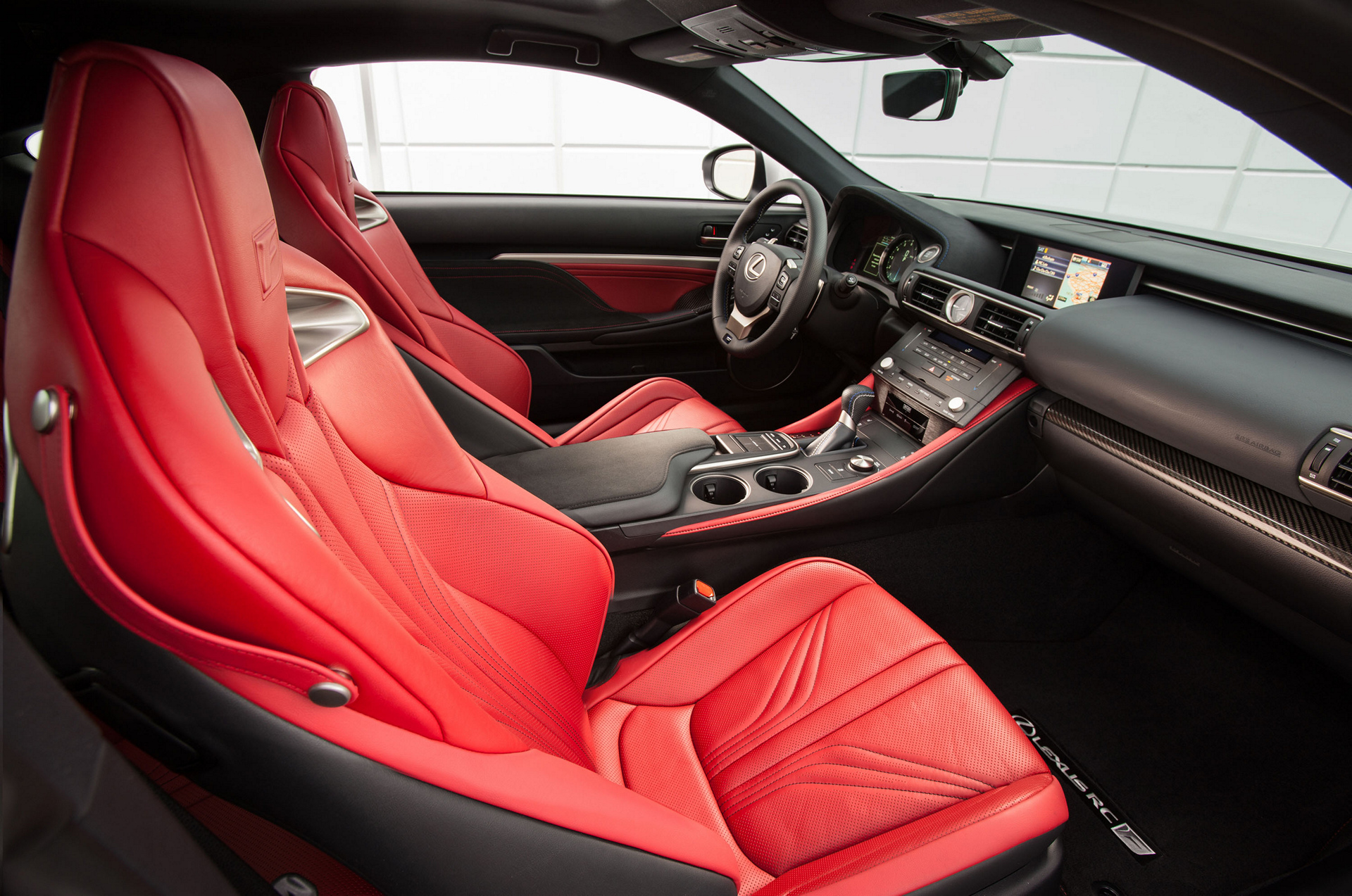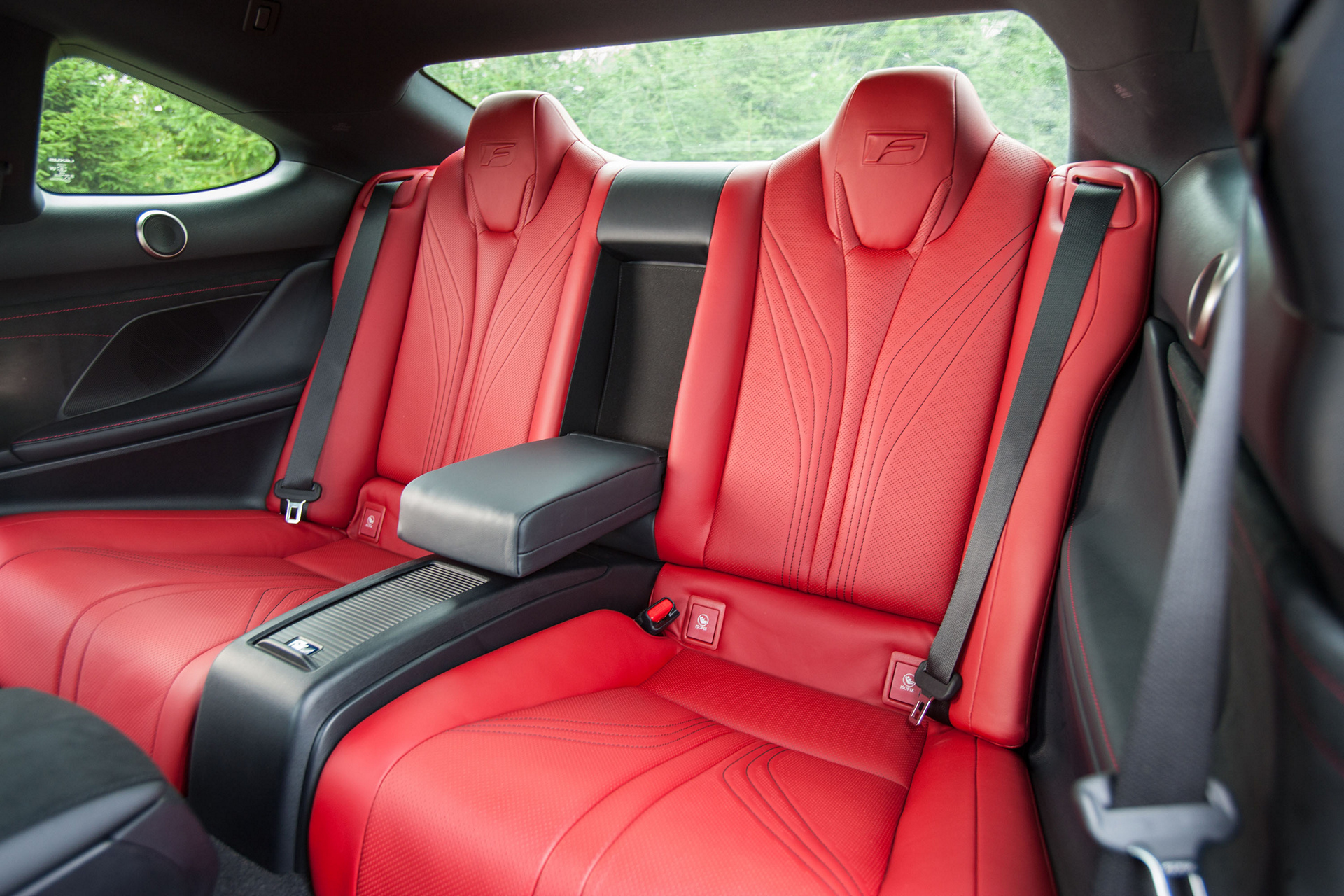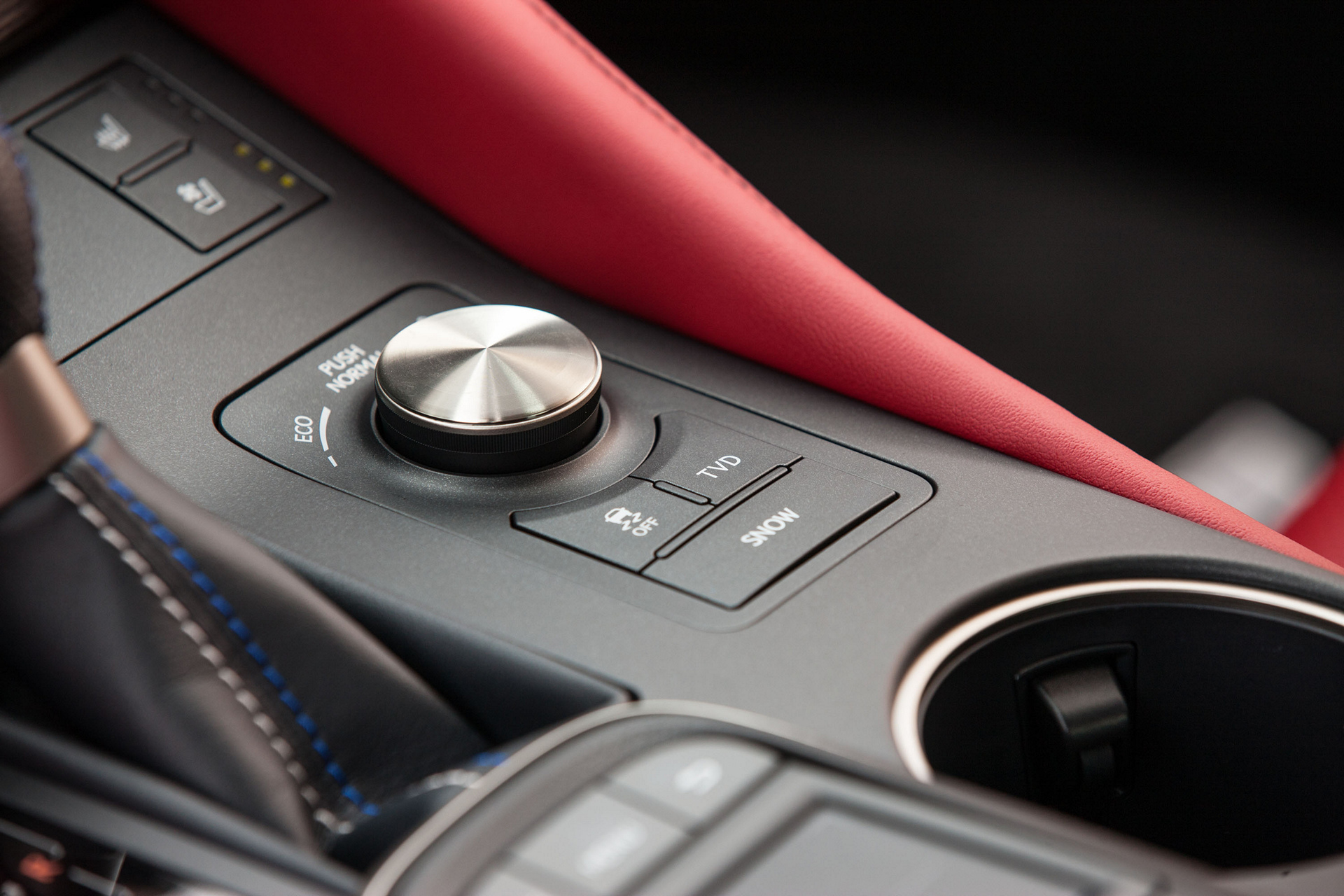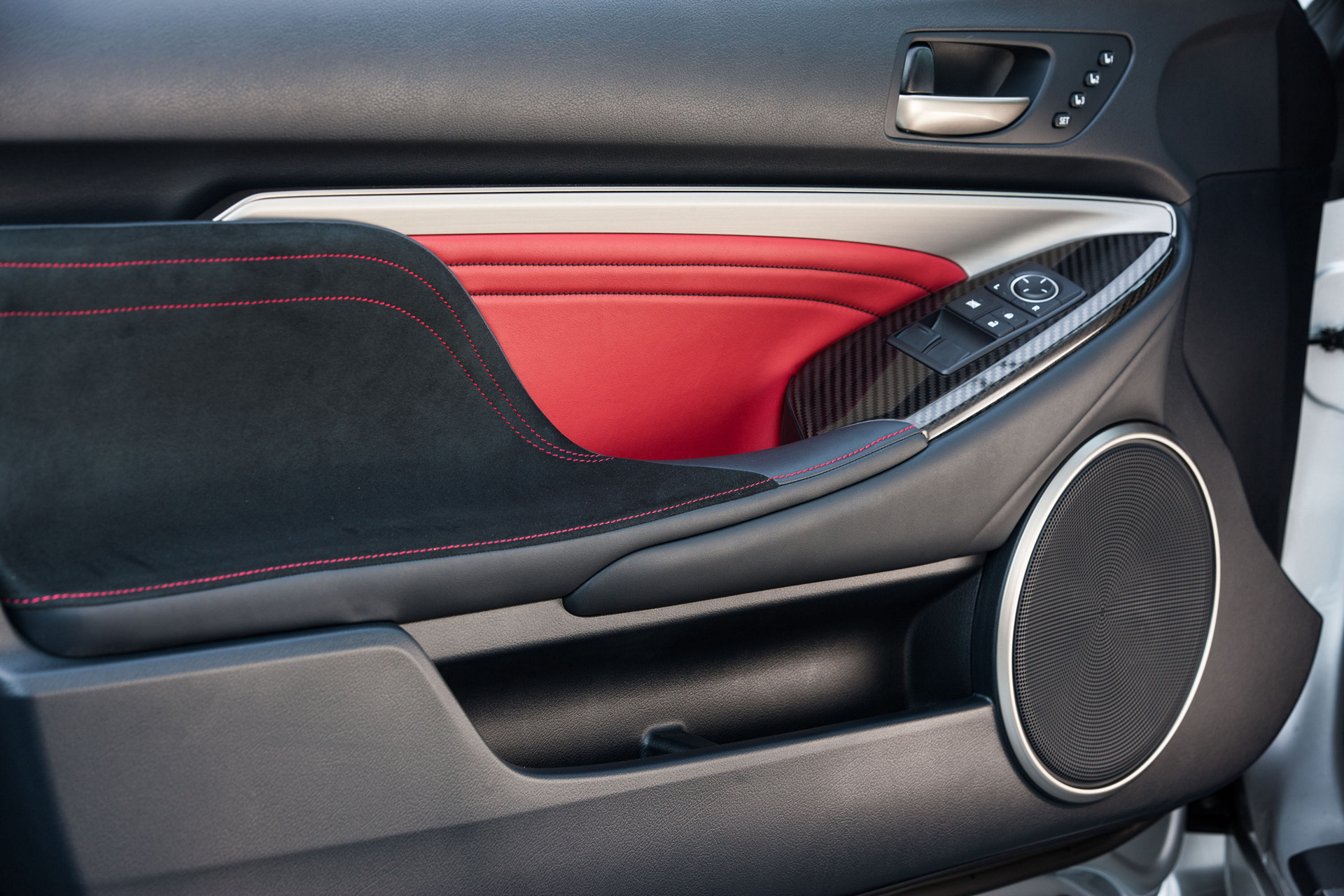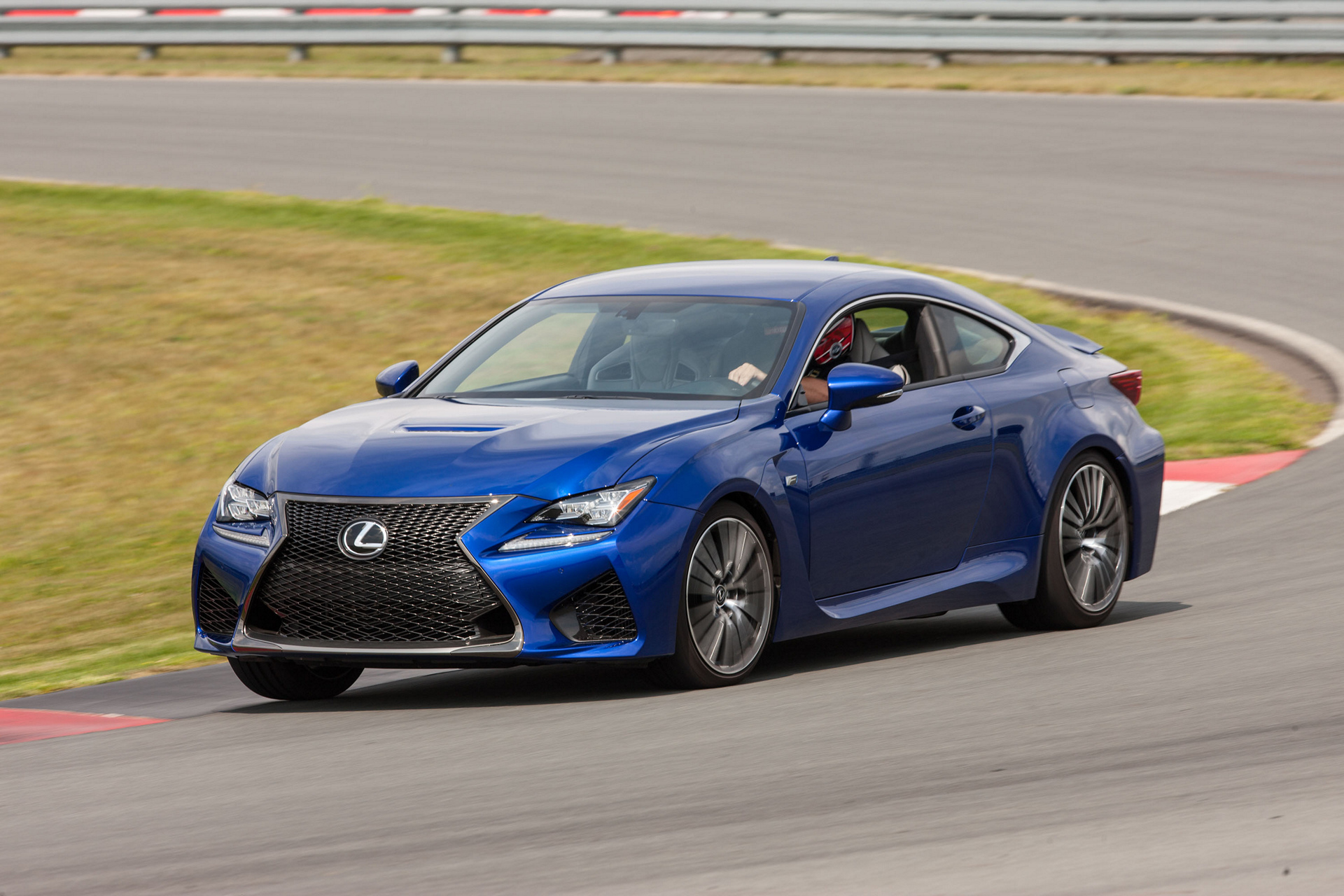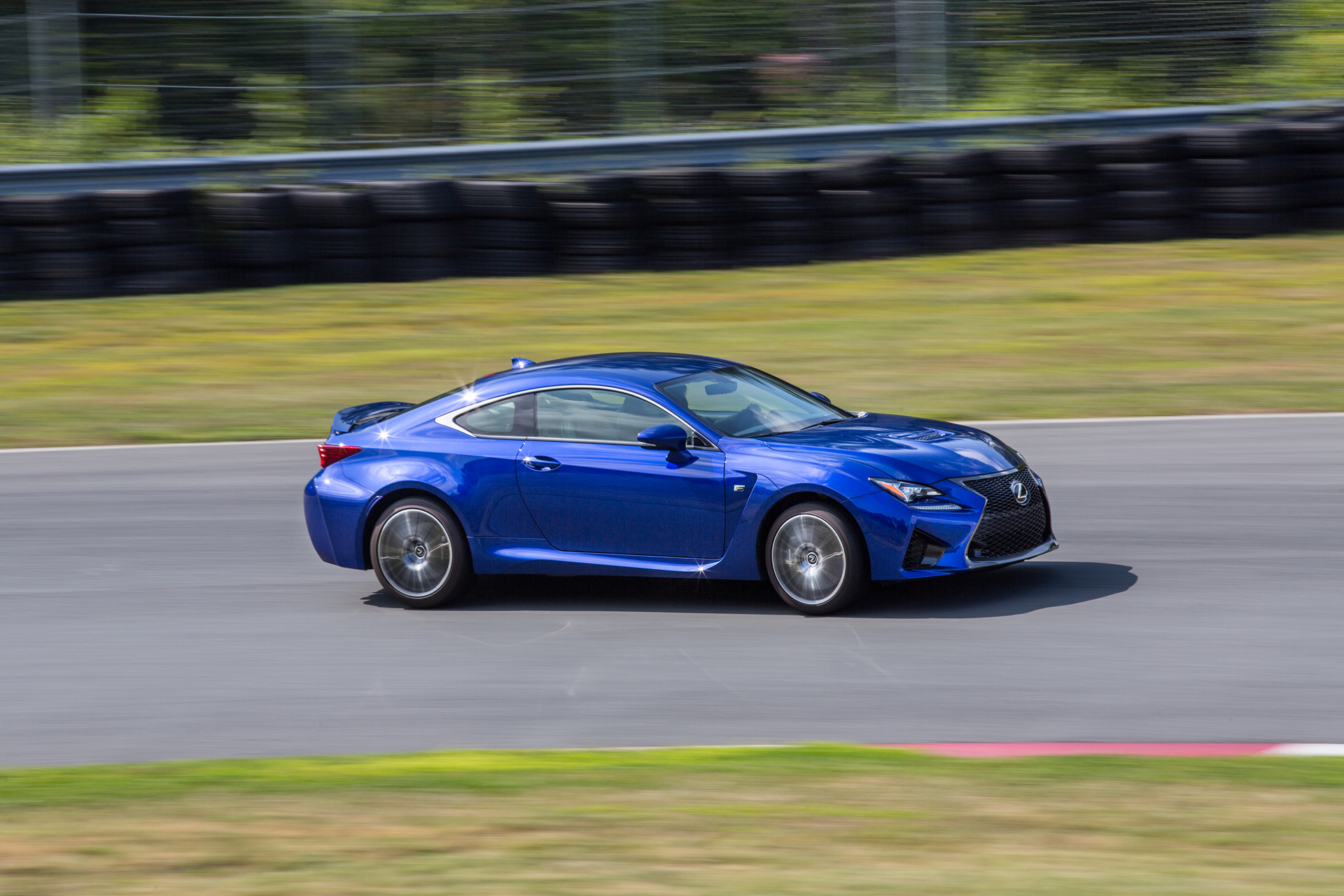Developed alongside the stunning RC sports coupe, the RC F is an extension of the F brand heritage and has elements of the LFA supercar and IS F performance sedan coursing throughout its design. It’s a jolt to the eyes with a more striking version of the RC body outfitted with wider wheels and tires, an active rear wing, air scoops, cooling ducts and available carbon fiber body features components. In the rear, the RC F features functional stacked exhaust tailpipes that make it even more distinctive.
First introduced for 2015 model year, RC F drives into the 2016 model year with Lexus Enform Service Connect and optional orange brake calipers.
Drivers can now opt in for additional peace of mind with Lexus Enform Service Connect. Lexus Enform Service Connect (one-year complimentary subscription) allows customers to remotely view information about certain aspects of their Lexus vehicle via the MyLexusandBeyond mobile application for iOS smartphone users or LexusDrivers.com. Information includes maintenance alerts, warning light notifications and a vehicle health report that includes email and push notifications for diagnostic information, required maintenance reminders, current vehicle alerts, service campaigns, and more.
The RC F packs a powerful punch with a 467-horsepower version of the F-tuned 5.0-liter V8, backed up by a close-ratio eight-speed Sports Program Direct Shift transmission and available Torque Vectoring Differential.
Lexus developed the RC F to excel on the track as well as the road. Body rigidity, suspension, brakes, tires and all other systems were developed with the expectation that RC F owners would be taking their cars to track day events.
There, they will enjoy the way the car’s electronically enhanced driveline, based on Lexus’ Vehicle Dynamic Integrated Management (VDIM), enables average drivers to get closer to limits previously attainable only by trained professionals. The same systems offer enhanced levels of active safety on the road.
Looks That Thrill
You see the grille first. The signature Lexus spindle grille looks menacing in black mesh, and when you look closely at the RC F’s grille, you’ll see the “F” motif repeated in the mesh pattern.
Built on the same 107.5-inch wheelbase as the RC, the RC F is slightly lower, wider and longer. The RC F is 0.2 inches (5 mm) wider than RC, thanks to its distinctive flared and laser-brazed wheel arches. It’s 0.4 inches (10 mm) longer due to the packaging of its rear aerodynamic devices, and it’s 0.2 inches (5 mm) lower. The stance, amplified by the wider, lower-profile tires, is even more of a ready-to-attack pounce than on the RC.
Yet, there’s nothing superfluous here. Every styling design feature of the RC F has a positive aerodynamic benefit. A continuous flow from the hood and front fender through to the belt line emphasizes the crouching nature and contributes to airflow.
Cooling ducts within the RC F grille supply air to oil coolers. At the rear of the front fender, a large L-shaped cooling outlet provides essential cooling and aerodynamic functions and also conveys the car’s performance enhancement.
The hood is raised in the center to accommodate and emphasize the V8, and a meshed vent in the center supports aerodynamics and cooling.
And there’s nothing reserved about the three different 19-inch wheel designs developed exclusively for the RC F.
A Body That Cheats the Wind
When it comes to beating the wind, cheating is acceptable. Designers seeking ideal aerodynamics for a high-performance car, though, must also accommodate pedestrian protection elements, in addition to the usual need to provide adequate cooling for a high-output engine and track-capable brakes.
All the intake and outlet ducts are functional, helping to cool the brakes and vent the engine compartment. The air outlets on the hood and fenders not only exhaust hot air from the engine compartment but also help to smooth the airflow toward the rear of the vehicle.
The RC F uses aerodynamics to help support stability at higher speeds. Some of the features are obvious, such as the auto-deploying four-link rear wing, while others, including aero spats and fins, blend into the dramatic coupe design. Yet, all aero elements work together to use the flow of air over and under the body to help enhance controllability at higher speeds.
The sharp cut-off at the trunk edge helps to smooth airflow from the roof when the wing is not deployed – and looks pretty sharp doing it. Rear bumper corners keep the airflow smooth, supporting the effects from the four-link active rear wing, a technology adopted from the LFA.
Lexus tuned the vehicle’s flat underbody, applying aerodynamic undercovers and aero stabilizing fins. Fins at the bottom edge of the rear bumper direct airflow from under the car. You’ll even find aero stabilizing fins on the tip of the doorframe molding and the rear lamps.
Front and rear wheel spats reduce airflow hitting the tires, while front fender liners are designed to help direct airflow along the tires, in the direction of wheel rotation. The rear fender liner has a bead to direct airflow generated by the tires to the outside of the vehicle. Even the shark-fin style roof antenna helps contribute to stability.
Wing Man
With technology adopted from the LFA, a wing deploys from the RC F trunk lid at a vehicle speed of approximately 50 mph to increase downforce as vehicle speed rises. As the vehicle’s speed drops below approximately 25 mph, the wing retracts. Alternatively, the driver can control rear wing deployment from the cockpit.
And for drivers who don’t mind even more attention while reducing vehicle weight, there’s an available carbon fiber reinforced plastic (CFRP) roof and rear wing, developed from the LFA and IS F CCS-R racecar.
467 Horsepower V8. Any Questions?
The 2UR-GSE 467 horsepower V8 runs on the Atkinson cycle when operating at cruising speeds, to help enhance fuel economy. It’s a trick picked up from the brand’s hybrids. In the Atkinson cycle, the inlet valves are held open longer than normal to allow a reverse flow of intake air into the intake manifold, thereby decreasing pumping loss and increasing thermal efficiency.
The VVT-iE (Variable Valve Timing-intelligent Electric motor) technology extends the range of inlet camshaft timing adjustment for the Atkinson cycle. The instant more power is called for, the engine switches to the Otto cycle.
Special features of the RC F engine include titanium valves, forged connecting rods, an optimized exhaust layout to more effectively harness exhaust pulses and an air-cooled oil cooler for optimum durability.
Active Sound Control
The sound blasting from the RC F’s quad stacked tailpipes is sure to turn heads and raise pulse rates. Yet, Lexus also had to design the cabin to be quiet enough to enable enjoyment of the standard premium sound system or sonically stunning available Mark Levinson® Premium Surround Sound system.
How could RC F drivers enjoy both? The answer is Active Sound Control (ASC), which lets the driver control enhanced exhaust, intake and mechanical sounds within the cabin. Specifically, Lexus sought to approximate the aural experience provided by the Lexus LFA, which issued some of the most stirring mechanical intake and exhaust notes of any supercar. Although LFA V10 engine revs to 9,000 rpm and RC F’s V8 to 7,100 rpm, the engineers have come close.
An electronic control unit mounted beneath the instrument panel takes input from engine sounds, including varying engine speed, vehicle speed and throttle position and generates augmented sound through an actuator. It is entirely separate from audio system, so there’s no reduction in music fidelity.
Most importantly is the driver controls ASC. It’s activated only in SPORT S+ mode, not Eco, Normal and SPORT S modes. And when it’s on, ASC blends with the natural intake and exhaust sounds to about a 50:50 ratio.
At engine speeds up to 3,000 rpm, ASC issues a steady tone of low and deep sounds.
As revs rise, the tone transforms into a higher-pitched note that blends with the engine’s mechanical sounds, culminating in a free-soaring sound beyond 6,000 rpm.
Drivetrain
Eight-Speed SPDS Transmission
The RC F 5.0-liter V8 finds the ideal dance partner in a specially tuned version of the eight-speed Sports Direct Shift (SPDS) transmission. Refined to suit the RC F’s new engine higher engine speeds, the transmission control program delivers a more linear response to accelerator input, and hence a more dynamic feeling.
The transmission offers the driver four selectable modes – NORMAL, SPORT S, SPORT S+, and M. The last one is of course for Manual, and in this mode, the SPDS applies full torque-converter lock-up from second to eighth gears for “clutchless” manual shifting. Upshifts are made in just 0.1-second in M mode, with the transmission’s throttle blipping control matching the engine speed to the gear.
The transmission’s SPORT S mode engages G-sensor AI-Shift control, which uses information from the vehicle’s G-sensors to provide the optimal gear ratio for more dynamic acceleration control.
In addition to performing quicker downshifts than SPORT S mode, SPORT S+ mode fosters more dynamic driving during high load conditions such as in track driving. The transmission will automatically downshift during hard braking for a corner, hold a lower gear through the corner for greater control, and then give the driver a greater power response on corner exit by selecting a suitable low gear.
For the rare times when an RC F driver wants to take a leisurely cruise, NORMAL mode provides the seamless acceleration traditionally associated with a Lexus electronically controlled transmission.
Driving Dynamics
Strengthen the Core
Starting with the ultra-high-rigidity RC platform, Lexus developed a special chassis for the RC F, more suitable for rigorous track driving.
As in the RC, the front section is based on the GS, but with increased apron panel thickness. The center floor section is based on IS C with its significantly enlarged rocker structure, and the rear floor is based on the IS with added center-floor gussets.
The RC F adds exclusive elements to the platform, including an engine compartment brace joining the front suspension towers, and a substantial V-shaped rear-partition brace. A cowl brace connects the front pillar section and apron member, enhancing steering response and roll feel. Rear suspension member mounts are strengthened to ensure maximum traction.
Lexus applied manufacturing techniques to yield a rigid body structure. Laser screw welding, additional spot welding and special body adhesives all do their part to give the RC F an exceptionally strong body. High-rigidity structural adhesive secures the windshield and rear window.
Use of high-tensile steel sheet and aluminum helps keep weight low. The hood inner and outer and the bumper reinforcements are aluminum, and the RC F offers the option of a carbon fiber reinforced plastic (CFRP) roof and rear spoiler. The available carbon fiber roof and spoiler help reduce weight from points far from the center of gravity, resulting in a tangible effect on handling agility. The CFPR uses a newly developed clear coat painting process.
Suspension
Seventy percent of the RC F’s double-wishbone front and multi-link rear suspension parts are different compared to the RC. They include front and rear springs, dampers and stabilizer bars as well as suspension bushings and rebound stoppers. The steering knuckle and front lower control arm were designed to alter the kingpin offset.
At the rear, all five of the suspension arms and the toe-control bracket have been designed to provide enhanced geometry. The upper number-one arm has been optimized for rigidity, and the upper number two arm and the end section of the toe-control arm are made from forged aluminum to reduce unsprung weight. Bushing characteristics of the other arms are also different than RC 350. High camber angles and toe-angle rigidity further enhance cornering power and reduce the required steering angle.
Electric Steering Feels Natural
The first thing RC F drivers will feel in the electric power-assisted rack and pinion steering is more feel. Intensive testing and calibration of the power-assist curve ensures the steering feel matches handling characteristics.
A damper-less intermediate shaft added to the steering column increases steering rigidity upstream and ensures high responsiveness to steering input. The shaft has a stroke-mechanism section that is expandable /contractible in the axial direction, to absorb shaft-length changes when driving and help provide a smooth steering feel.
Wheels: Forging A Connection to the Road
Of course, the Lexus RC F owes much of its agility to specially developed tire packages. Lexus RC F has three 19-inch wheel choices, all made from forged aluminum for optimum rigidity and minimum weight.
The RC F uses a staggered wheel and tire setup, with 255/35R19 front and 275/35R19 rear tires. A flat tire repair kit in place of a spare tire saves vehicle weight.
The standard wheel is a split five-spoke design. The optional wheel is a split ten-spoke design, each spoke with a machine finish. Another optional wheel is a hand polished 20-spoke, with two layers of 10 spokes. The inner layer is indexed 30 degrees ahead of the outer layer.
Torsen® Rear Differential
No sports coupe promising track performance would be caught without a Limited Slip Differential (LSD). The RC F comes standard with a Torsen LSD and offers the option of a Torque Vectoring Differential (TVD).
The Torsen LSD offers high levels of traction performance, handling and driving control. Three key benefits stand out:
During straight-line driving, the Torsen diff controls the left-right speed differential to maintain straight-line stability. On entering corners, the coasting torque due to engine braking is distributed more to the outside wheel, to help maintain stability. Mid-corner and on corner exit, the Torsen LSD distributes drive power according to the load on each rear wheel, to help ensure high traction and maneuverability.
Torque Vectoring Differential
It would be no surprise that a car of the RC F’s track capability would offer torque vectoring to sharpen handling response. The news here is that the RC F uses the electronically controlled Lexus Torque Vectoring Differential (TVD). The TVD uses precisely controlled multi-plate clutches, rather than the vehicle’s brakes, to optimally distribute torque to each rear wheel whether or not the accelerator is pressed.
The design aim with a TVD-equipped RC F was to make full use of the vehicle’s yaw moment for turning posture so good that it would feel as if the steering angle and direction of the vehicle travel were solidly joined.
Electronic control and precision electric actuator motors that are adjusted in units of 1/1,000-second ensure the appropriate amount of torque is distributed to each rear wheel. TVD can generate torque transfer regardless of how large or small the engine torque is, creating a yaw moment around the center of gravity and realizing movement similar to the LFA with its 48:52 front/rear weight distribution.
The driver won’t notice the TVD’s seamless operation but rather will simply enjoy the feeling of using the accelerator pedal to help steer the car through corners.
The TVD distributes torque to match the conditions of the moment, helping to ensure dynamic response when negotiating S-bends, for example. It improves vehicle attitude in low-to-mid speed corners, providing more agile movement and a smaller steering angle.
In a series of S-bends, TVD provides exhilarating corner exit performance with no understeer. Crisp turn-in after hard braking is equal to highly skilled driving without a TVD. Even during deceleration, the TVD constantly controls the drive force to preserve agile and smooth turn-in.
The TVD has three operating modes, independent of the RC F Drive Mode Select function:
- STANDARD (default setting) provides an ideal balance of agility and firmness.
- SLALOM emphasizes nimble steering response and the agility of a smaller vehicle.
- TRACK emphasizes stability during higher-speed circuit driving.
The RC F’s unique cockpit meter display shows the rear-wheel torque distribution as a bar graph within the tachometer and, if selected from the display menu, as two orange columns in the multi-information display.
How it Works
The drive-force control mechanism in the Lexus TVD consists of two highly responsive and compact motor control units and two multi-plate clutches. The system also includes a set of speed-multiplication planetary gears for each drive shaft.
The brushless electric motors have a newly developed built-in high-precision resolver (rotation-angle sensor). Using technology developed for hybrid vehicle motor control, these allow the motor angle to be monitored and adjusted in units of 1/1,000-second, for precise control of torque distribution during acceleration and deceleration. Each electric motor controls the pressure on the corresponding multi-plate clutch via a ball-cam actuator.
Special features of the TVD electronic control include feed-forward and feedback control technology. Feed-forward control is control due to driver input. Feedback control aims for the ideal vehicle condition, even in situations such as counter-steer during a drift, for more enjoyable maneuverability.
The feed-forward control group includes steering-angle, LSD during counter-steer and LSD during deceleration. The feedback control suite includes yaw-rate, differential-rotation suppression control and VDIM cooperative control.
VDIM: The Invisible Hand
Even expert drivers, who turn off their cars’ electronic control systems during track driving, might like to have an invisible hand helping out in dicey situations. The 2016 RC F offers that hand in the EXPERT mode of the Vehicle Dynamic Integrated Management (VDIM) system.
First, a little background on VDIM: Starting with its hybrids, Lexus has for a number of years equipped its vehicles with VDIM, which coordinates control of the powertrain, ABS, electric power steering, traction control (TRAC) and Vehicle Stability Control (VSC) systems. VDIM is designed to anticipate a loss of traction and help coordinate the separate active safety systems of VSC, TRAC, and ABS to work in concert to correct it by seamlessly integrating control of basic ‘drive-turn-stop’ vehicle performance. VDIM function also includes Hill-Start Assist Control (HAC).
In the RC F, there are four modes:
- Normal mode for regular VDIM control
- VDIM SPORT mode to give priority to driver control
- New EXPERT mode, which only intervenes to prevent a spin with VDIM off
- OFF setting, no control by the VDIM system.
NORMAL mode provides smooth driving and helps to enhance active safety under normal driving conditions. VDIM SPORT mode offers greater potential for track-day use, applying optimum VSC/TRC mapping for track driving. Track tests by professional race drivers showed better performance with VDIM SPORT mode than when driving with VDIM OFF.
EXPERT extends the control parameters to enable the driver to fully exercise individual driving skills and help control the vehicle in a similar fashion to driving in VDIM OFF mode.
Before being used on the RC F, the new VDIM technology was refined through testing on racecars. The logic control has been significantly enhanced and new functions added to further enhance both driving enjoyment on the track and reassurance when driving in marginal-traction conditions.
In addition, Lexus has extended the VDIM cooperative control function, allowing the system to delegate two brake control functions to the TVD: drive-force distribution and yaw-moment control. VDIM controls the torque transfer cooperatively with the TVD, for more seamless control of driving and turning.
Cutting Through the Night
Those winding roads that sports car drivers love to explore tend to lack streetlamps. The RC F cuts through the darkness with standard LED headlamps and separate L-themed daytime running lamps (DRLs). They flood the road with light and give the RC F a powerful face.
Available unique shaped lenses and multi-LED lamps are used for both high and low beam. Each of the three LED lamps in the high-grade headlamp contains both high and low beam lamps. And all three are lit when the headlamp is on. The L-shaped low-beam lamp expresses the Lexus identity.
Penetrating LED lamps generate heat, so a small thermostatically controlled cooling fan is installed behind each headlamp assembly.
Distinctive Rear Light Signature
Lexus designed the RC F to leave a distinct nighttime signature as it passes – which it will be doing often. Like the headlamps, the rear combination lamps show the distinct Lexus L-shape motif. But, rather than simply embed the motif as a graphic element within the lamp unit, the surface is raised to create a three-dimensional “L” effect.
A clever lens design gives the sparkling-gem effect of 50 LEDs per side but uses 24 per side. There are two inner lenses, a stepped inner lens and an outer lens with a series of multi-layered serrations on its surface, three for each LED bulb.
Designed for Track Drivers, by Track Drivers
Wouldn’t it be something if a driver could be fitted for a regular production car’s interior? Lexus designed the RC F cockpit to come as close to that ideal as possible, equipping it with generous seat position adjustment range and seats that conform to the occupants’ bodies.
For cabin design inspiration, Lexus again turned to its LFA supercar. Unique components for the RC F include the gauges, steering wheel, seats, trim and pedals. All are designed to give the driver the most direct connection to the road possible, yet still provide everyday comfort. There’s no skimping on luxury, either. The RC F, for example, shares interior ambient illumination package with the RC line. Upward-reflected light from door panel LEDs creates a feeling of welcome like that used along the pathways of homes.
Form-Fitting Seats
Lexus designed the RC F’s front for track driving, though of course they also provide all day comfort for the road. The high-back design with integrated headrests and side bolsters provides optimum support for the back in mid-g cornering and additional shoulder support in high-g driving. The cushion’s design helps hold the driver’s leg in place when pushing down on the foot brace.
Special integrated foaming construction helps the seats conform to the person’s body.
The upholstery is set into the mold, which is then filled with foam to complete the seat in one process. This contrasts with the conventional method of seat construction where the molded foam pad is covered with upholstery. Using the integrated foaming method, the material does not need to be stretched as tightly over the foam, resulting in a premium feel and high-precision appearance. Filling the seat in a single process also eliminates wrinkles and slippage of the cover.
For the RC F seats, the foam is applied in three sections – to the shoulder, lumbar region and hip – each intended to mold to the body. The sewing and stitching process also allows the seat to change shape to conform to the body. Grooves in the seat cushion where the occupant’s hip contacts it cushion enhance the feeling of fit while preventing the hip’s forward slip and wobbling, helping reduce fatigue.
The rear seats, with fixed high headrests, use the same sewing pattern as the front seats to conform to the occupant’s shape. A dual manual-electric folding mechanism provides easy access to the rear seats by overriding electric controls but retaining a memory function for the return of the seat-back to its pre-set position.
For maximum body rigidity, the RC F has a stationary seatback. Rather, it provides a trunk pass-through for carrying longer items, such as snowboards or skis. The luggage compartment has a maximum capacity of 10.1 cu. ft. and can store two full-sized golf bags.
Driver Control
With chassis and suspension engineered to give the RC F an uncanny connection to the road, Lexus designers rose to the challenge of creating a cockpit that connects the driver to the car in a way familiar to race drivers.
A low hip point and a raised steering wheel angle create a linear driving position in the RC F, for a feel that’s more racecar than road car. The RC F’s exclusive small diameter (14.6 inch) three-spoke steering wheel has a thick rim with built-in finger rests and provides easy access to the large paddle shifters.
The Lexus RC F revives the true meaning of “instrument panel” with a control center packed with cutting edge electronic displays. The analog speedometer, to the right of the larger tachometer, is designed to evoke the look seen in classic sports cars. But there’s nothing retro about the displays surrounding it.
When the driver’s door opens, the speedometer illuminates as a welcoming gesture. Then, when the driver sits down and closes the door, the speedometer flashes in a way that is evocative of heartbeats – signaling anticipation for the engine to be started. Once the engine is started, the multi-information display presents the RC F logo, and out of the screen’s darkness, a front view of the car emerges.
The unique TFT display tachometer, surrounded by a large-diameter machined aluminum ring, is the central gauge in the display. But it’s not always a tachometer. The meter display changes according to driving mode (Eco, Normal, Sport S and Sport S+), designed to provide pertinent information in an instant.
The multi-information displays vehicle status images during mode switching. In SPORT S mode, the display resembles that from the LFA. The tachometer peak position is set just before the 7,000-rpm mark. The speed and shift displays are inverted from Normal mode, and the shift range character size is increased, making the essential shift position reading easier to see during performance driving.
A Rev indicator uses indicator lights in three stages along the ring — yellow, orange, and red. The third stage flashes and is accompanied by a buzzer.
In SPORT S+ mode, the dial indicator is replaced by a bar type tachometer, which makes engine rpm more easily visible even when the meter cannot be viewed directly. In addition to the vehicle speed and shift position, the meter display shows water temperature and oil temperature.
The panel offers other treats for enthusiast drivers, including a lap timer function, G-force display and torque distribution display (for cars equipped with the Torque Vectoring Differential). A vehicle monitor display can show tire pressures and active rear wing status.
Like A Smartphone: Remote Touch Interface
The Remote Touchpad uses smartphone-like touch gestures — including tap, flick and pinch — to operate audio, navigation or system information displayed on the center screen, without the user having to look down.
Moving one finger over the touchpad surface moves the cursor, and pressing down or double tapping enters the selection. An integrated feedback function vibrates the surface when the cursor on the electro multi-vision navigation (EMVN) screen moves over a button. You can confirm the cursor movement without looking at the display.
Premium Audio: Digital “Decompression” Chamber
Since its inception, Lexus has continually pushed the advancement of mobile audio. Both the standard and optional RC F audio systems play all popular digital formats, whether from CD, iPod®, USB or other device.
Both also integrate new audio restoration technology that was introduced in high-end home systems only recently. The technology restores some of the clarity lost during compression for digital formats commonly used today.
The standard audio system drives its 10 speakers – including a 10-inch subwoofer — with 256 watts total output. The speakers include 3.5-inch left and right dash speakers, a 2.6-inch
center dash speaker, seven-inch front-door speakers and 6.3-inch rear side panel speakers. The subwoofer is mounted beneath the rear panel.
In the RC F, the available Mark Levinson 17-speaker system creates a stunning 360-degree, three-dimensional sonic space. The system produces 835 watts total output while consuming less power than other systems of similar output. The control panel was designed to resemble the simple designs used on Mark Levinson home equipment.
The system includes: 3.5-inch left and right and center dash Unity™ speakers; seven-inch front door speakers; one-inch center pillar speakers; 6.7-inch rear side panel speakers; rear corner 3.5-inch Unity speakers, and the 10-inch subwoofer. (The Unity speakers are dual-driver.)
The Clari-Fi technology automatically analyzes compression in the signal of digital tracks (CD, iPod, etc.) and determines how much amplification is needed, and where, to correct it. The result is a cleaner sound that is closer to the original recording.
Climate Control: Emphasis on “Control”
“Dual purpose” as applied to a performance car used to mean you could drive to the track, and drive home. It still does, but today it also means the “to” “from” parts are done in comfort. The Lexus RC F’s automatic climate control system includes two-layer control of internal and ambient air and upper/lower level independent air mixing, as well as independent left and right temperature control.
By dividing the intake air ducts between internal air and ambient air, the RC’s climate control system prevents a drop in temperature caused by ambient air intake when the heater is on, thereby increasing heating efficiency and saving energy.
Independent upper and lower multi-layer air mixing enhances comfort by providing control that matches conditions. For example, on a colder day with bright sunshine coming through the windshield, you can set the upper air mix for cooling while at the same time have the lower air mix set for warmth. The RC air conditioning system includes the hallmark Lexus feature of a pollen-removal function, as well as a clean-air filter with deodorizer.
The control panel uses a high-contrast negative liquid-crystal display for clear visibility. Advanced electrostatic switches in the control panel provide temperature control.
Braking Good
The Lexus RC F driver will know the car is going to deliver on the track from the first run through the gears. The first stop will instill equal confidence in the brakes.
The RC F has an exclusive brake package featuring 15-inch diameter spiral-fin front rotors, improved brake cooling and a vertical g-sensor as part of the anti-lock brake system control. The vertical g-sensor came as a result of extensive testing at the Nürburgring. It allows for changes in vertical loads, and hence optimizes control of braking force the instant load returns to the tires after jumping a crest.
The RC F’s 15-inch by 1.3-inch ventilated front rotors are slotted rather than drilled, with six-piston opposed calipers. The rear brake rotors are 13.6-inch by 1.1-inch ventilated, with four-piston opposed calipers.
The large rotors help ensure linear controllability in a range of g-force ranges during continuous track driving, while providing a direct feeling during everyday driving. The pads are designed to ensure long life and reduced chance of uneven wear. The RC F brakes also reduce booming noise during high-speed braking.
The hardware also includes a brake booster and master cylinder design and a high-rigidity pedal, to enhance response and shorten pedal stroke, with g-force generated aligning with pedal stroke.
Exclusive RC F hydraulic control circuitry optimizes brake control and the interaction with the ABS/VDIM Mode Select feature. ABS operates in harmony with RC F’s optional Torque-Vectoring Differential, to suitably control drive force and braking force at each of the four wheels.
Eight Airbags
Lexus RC F has eight SRS airbags, including a dual-stage driver’s airbag, dual-stage and dual-chamber front passenger airbag, driver’s and passenger’s knee airbags, front-seat side airbags and first and second row side curtain airbags.
Pre-Collision Systems (PCS)
The Lexus RC F offers the added peace of mind of available Pre-Collision Brake and Pre-Collision Brake Assist systems. Using the radar sensors of the Adaptive Cruise Control, these systems are designed to detect the potential for a collision between the RC F and an obstacle or vehicle ahead. Both systems can operate brake control to help reduce impact.
Warranty
48-month/50,000 mile basic limited warranty with roadside assistance for 48 months/unlimited miles.
72 months/70,000 miles powertrain and restraint system coverage.
72 months corrosion perforation protection coverage, regardless of mileage.
Price
Recommended retail price (MSRP) starts from $62,805







































